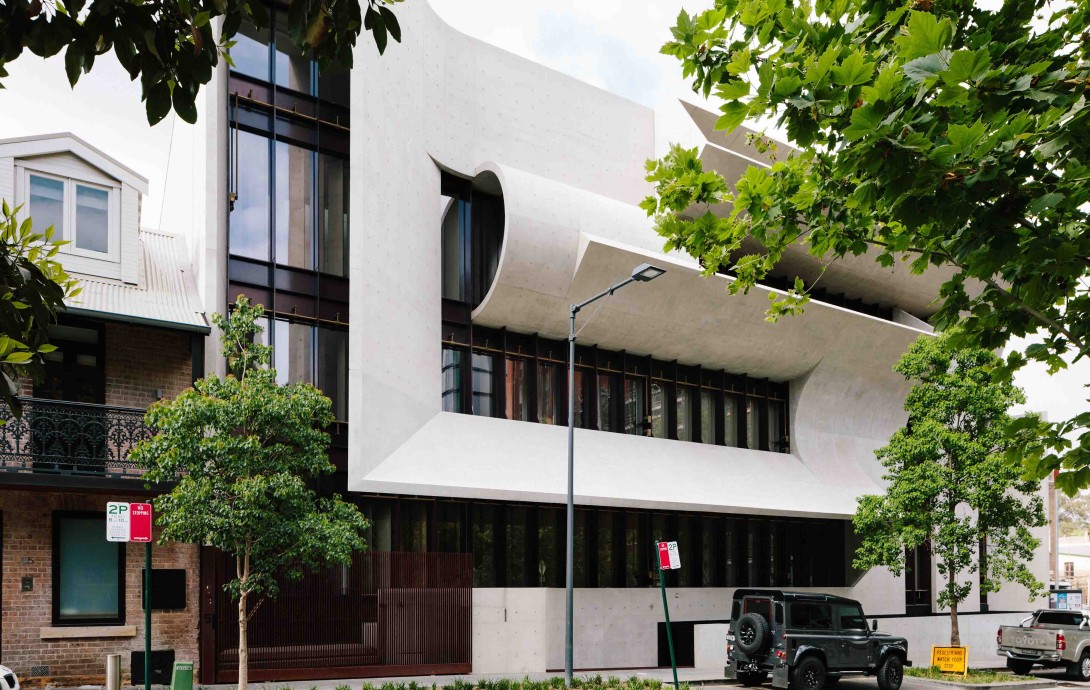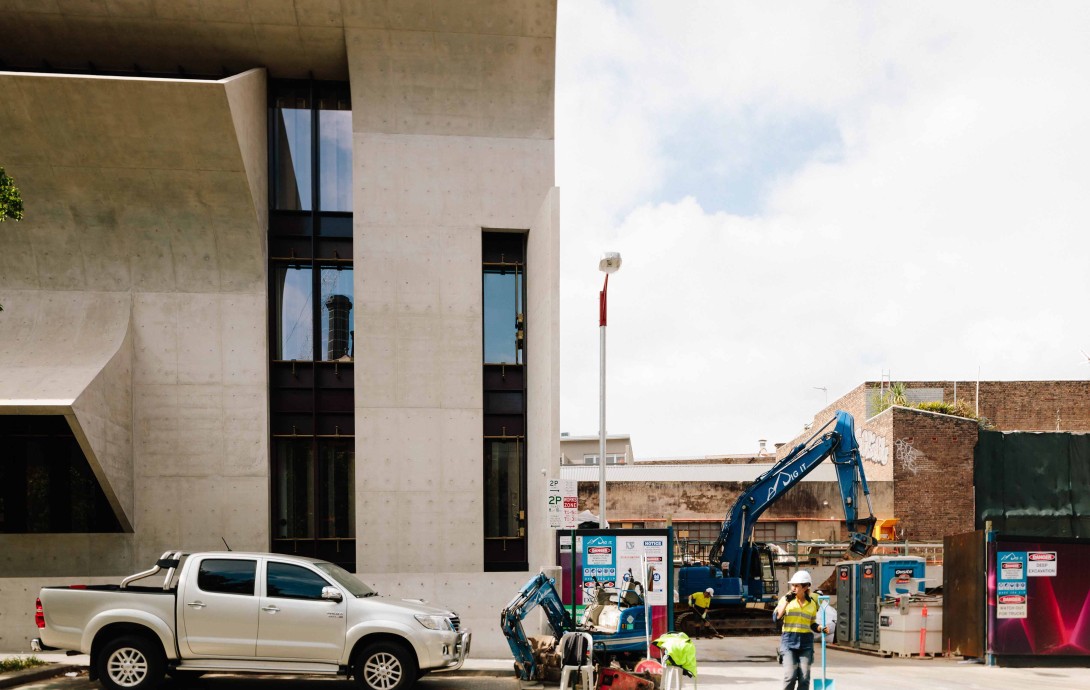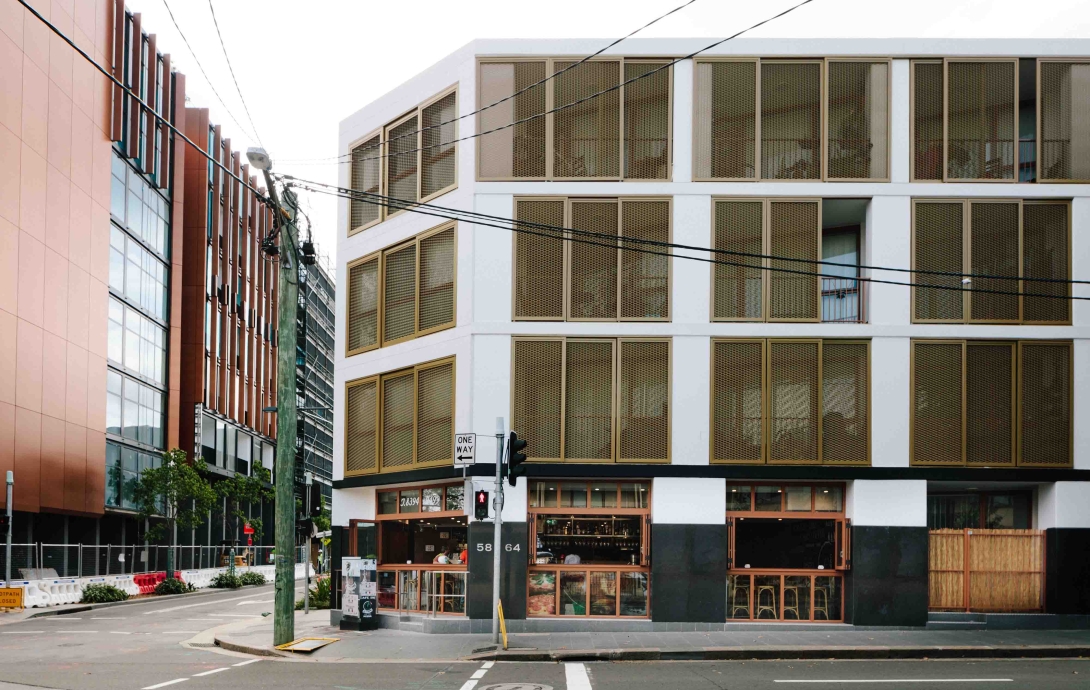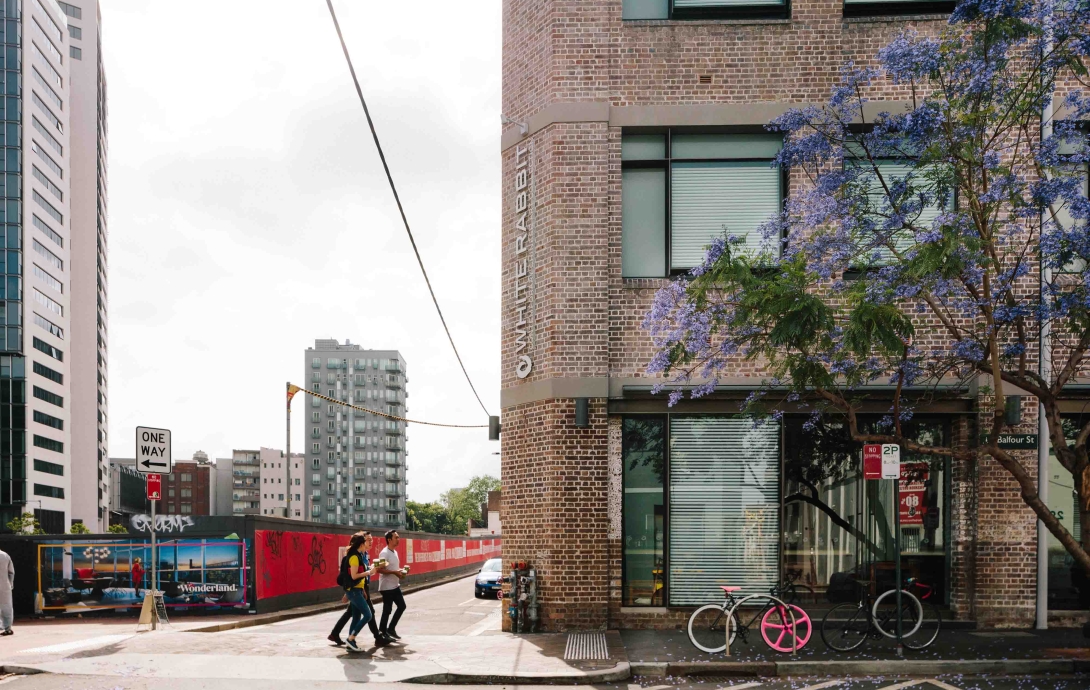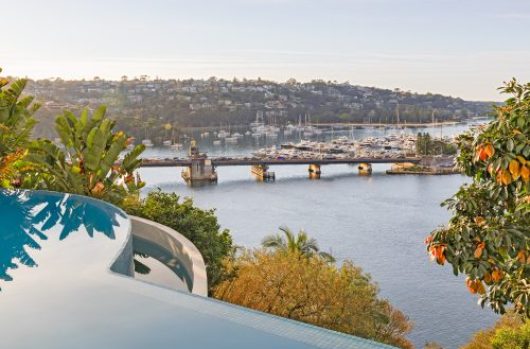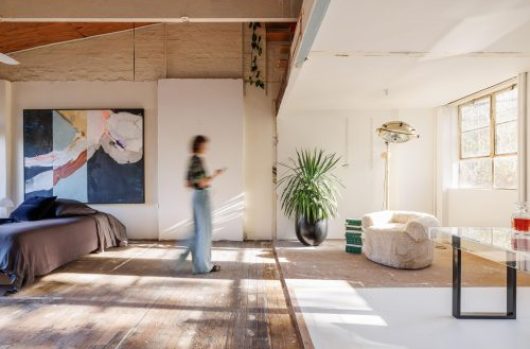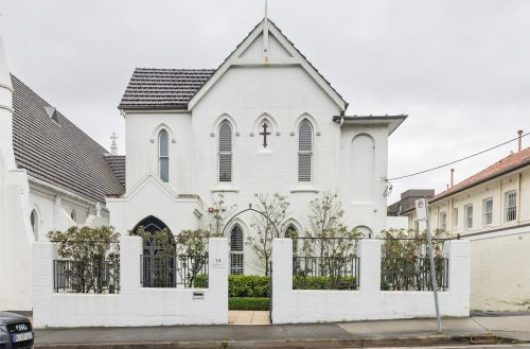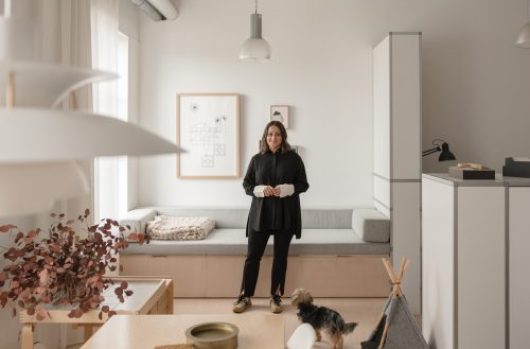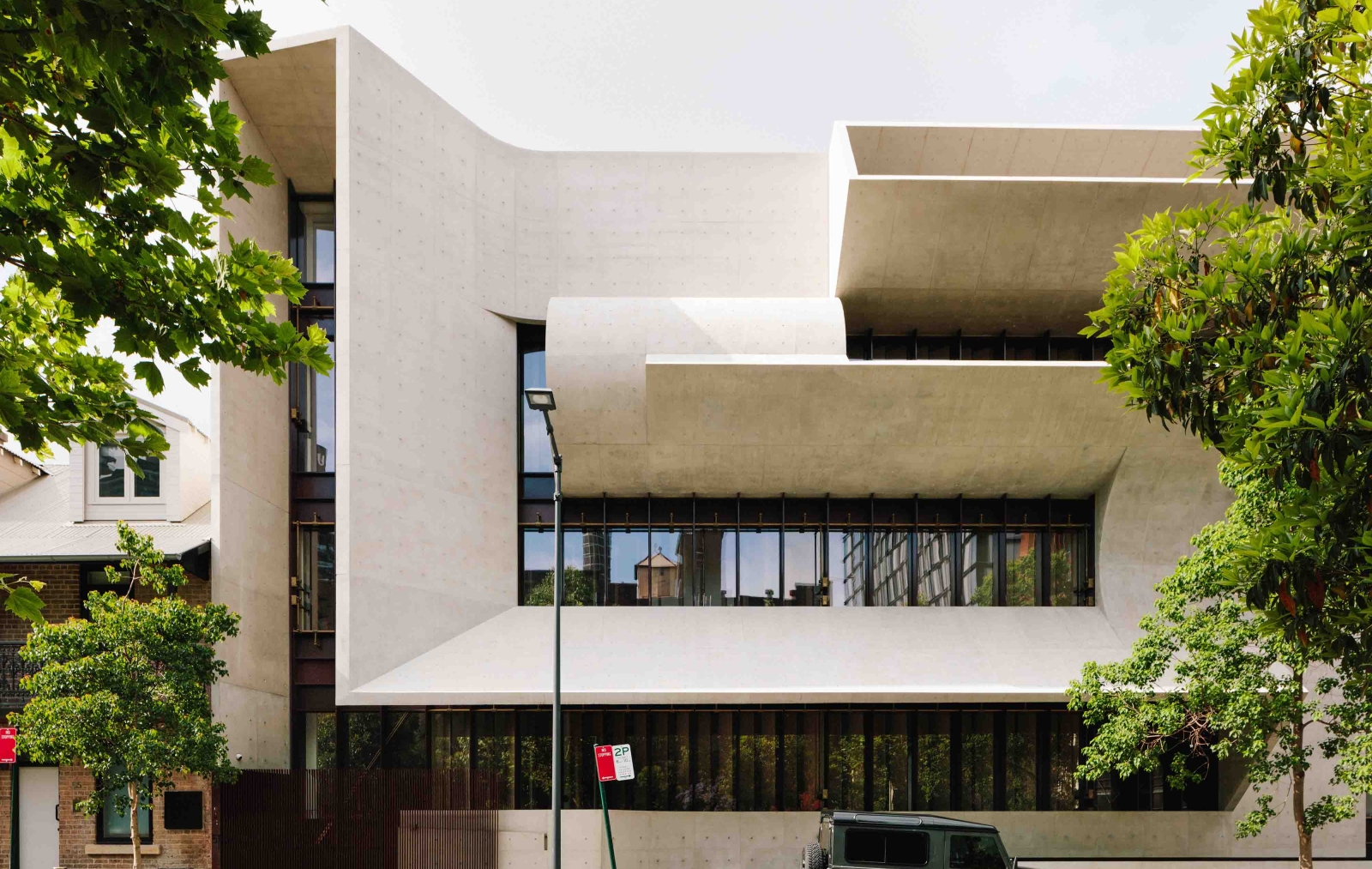
O’Connor Street gets crucial
Wedged between Central Station and the University of Sydney, Chippendale is one of Sydney’s tiniest suburbs. But Chippendale is getting crucial, as we discover from talking to Sydney locals.
In June, Smart Design Studio revealed a private residence called Indigo Slam for local resident Judith Neilsen. Nielsen is the owner of White Rabbit Gallery around the corner and has shown a cultural agenda in her Monopoly moves around the ‘burb. She knows Chippo ain’t going back.
Once covered with nineteenth century workers’ terraces and light industrial buildings – O’Connor Street is now sprouting luxury apartments and flash new hotels. So is this a street coming of age? Or is it just another arts district being cleaned up for the well-heeled?
A walk down O’Connor Street today reveals a scene of high contrast. Newly poured cement pavements are sprayed with fluorescent spray paint. Grotty terraces littered with old mattresses and used frying oil cans out the front butt right up against award-winning architecture. To an outsider, it is still looks like a developing world hodgepodge of good and evil.
By night, the street changes into a dark wind tunnel with creepy corners and unfinished surfaces at easy reach. Kids sit on the grass at Central Park drinking goon from casks, while local residents can be seen in silhouette, getting fit at a nearby dance studio. Around the corner, hip places to dine have queues of Broadsheet readers out the front, while closer to Broadway, Spice Alley invites students to eat prawn laksa with plastic chopsticks. By day, shitty cafes run by backpackers with pink hair amble on making piccolos just near Abercrombie, while further down, old warehouses on deep blocks promise yet further magnificent residences for the street.
At least three earth pit construction sites dot O’Connor Street. With their sheet plastic and high fences, they’re a symbol of yet more modern developments to come. Directly opposite Indigo Slam on O’Connor Street, one of the last remaining derelict buildings sits ready to be converted into the mother-of-all 5 star hotels. It’s the new project of media-shy Melbourne property developer, Adam Garrison, who is making plans with award-winning Melbourne-based chef Shannon Bennett, of Vue du Monde fame. Nearby, The Brewery Yard designed by TZANNES for Frasers Property and Sekisui House, has already received the 2016 Award for New Design in Heritage Contexts, at the UNESCO Asia-Pacific Awards for Cultural Heritage Conservation.
Architect William Smart, who has been active in the street of late, is so busy collecting awards for Indigo Slam and finishing off his next apartment project, The Connor, he barely has time to draw breath. He says designing Indigo Slam for local billionaire Judith Neisen was a dream assignment.
“Indigo Slam represents a rare opportunity to add a large residence of substantial quality and architectural merit to the diverse neighbourhood of Chippendale and to participate in the reinvigoration in this part of Sydney as a place of architectural and cultural interest,” Smart says. Reinvigoration is a buzz word on O’Connor Street for sure.
According to Smart, the brief was for the building to last 100 years, and materials and fittings were selected to wear and endure. For example, all operable elements like shutters and windows are mechanically, rather than digitally operated. While designing a building to last 100 years is not revolutionary, the most exciting part of the residence is the active facade in that smack bang location. “The concrete facade is alive to the changes wrought by light, shade, sun and cloud,” says Smart. “The facade also provides the new urban park over the road with a lively backdrop to public life,” he says. It’s sculpture in the street.
No on can deny the lasting change Judith Nielsen’s investment has had on Chippo. She now owns several warehouses in the area and her daughter Paris is rumoured to have bought the site next-door to Indigo Slam for a large performance space. “She keeps buying,” says local Greencliff developer Marcus Chang. He says their mob tend to ‘leave her alone’ when she comes walking up Kensington Street with people ‘hanging off her’. Chang is another local shaker. While he doesn’t live in the city, he has been involved with the area since the initial purchase of the site in 2003. He says in the future O’Connor Street will only become more consolidated, with every millimetre eventually infilled.
“The city is growing outward. So in the future Chippendale is just going to consolidate. It’s so close to the city and has really gotten rid of its bad rep,” says Chang, who admits he likes to drive from his home in Manly on Sunday nights to see what’s happening at his Spice Alley and design precinct project, Kensington Street. “I think in 50 or 100 years from now, Chippendale is going to be very well known as an education precinct because there are 150,000-odd students and teachers in this area at peak times and in the future that means it should really consolidate and in-fill. Not spread out too much,” says Chang.
Chang is the business partner of Stanley Quek who had the initial vision for Central Park as the head of Frasers. Today, the knock-on effect of that vision is deeply felt on O’Connor Street. Even despite the progress, Chang says its still important to keep getting the mix right. He says it’s important for landlords to ensure commercial sites are balanced with right amount of residents and independent retail.
“You know there are 1,400 finished properties next door here in Central Park and there are another 800 apartments coming soon. You’ve got two more hotels coming – one above the Abercrombie Hotel on the corner and Adam Garrison’s project in the old CUB site,” he says. “It’s growing by the day. Our vision for here was more like a Chelsea in New York,” says Marcus recalling the start of the project. “We wanted it to have a real mix.”
Chang says they always pictured Chippendale as a mixed-use area staying true to its artistic roots and making room for independent fashion. But they had to allow for the Sydney market and tailor the offering on Kensington Street to the urban obsession with food. That is why so much of Central Park has become and eating and drinking precinct. When we meet he points out the new wine education centre by Handpicked which is set to open and service people in the area. “I think if those warehouses on O’Connor Street can be retained they are going to be worth a fortune on day,” he says wistfully, as he contemplates what urban life will be like on O’Connor in 50 or 100 years from now.
Sydney Urbanist Linda Gregoriou says she loves Chippendale for its mash-up styles and demographics. “What has transformed Chippendale is Central Park. Spice Alley, the student housing and the public art. That is what has made Chippendale interesting – it is not about one single building,” says Gregoriou. “I think Indigo Slam has enhanced that, and added value from a cultural and artistic perspective, but it is not the thing that has actually made O’Connor Street gentrified, it is a result of gentrification,” she says.
“For me what I love about Indigo Slam is the fact that the scale is juxtaposed with the surrounding context. And I do think that whole space works. I think Central Park is one of the best public spaces in Sydney. It’s good because you have variety of spaces, a variety of uses and a variety of demographics. You have variety of incomes or socio-economic backgrounds and it is not all homogenised,” Gregoriou says. Or at least, not yet. No one wants Chippendale to become boring. It’s a little island surround by arterial roads and its needs locals to make it work. All agree that having some link to its artistic roots is critical to the area retaining some street cred.
So out of the ashes, O’Connor Street is rising like a beautiful phoenix with renovated terraces, multi-million dollar properties, cafes, design studios and access to transport. But what next? Could O’Connor Street one day be an inner-city Beverly Hills for Sydney or become our answer to Daikanyama in Tokyo? Could luxe and grunge finally exist in one inner-city locale? The answer is in the wind tunnel.
